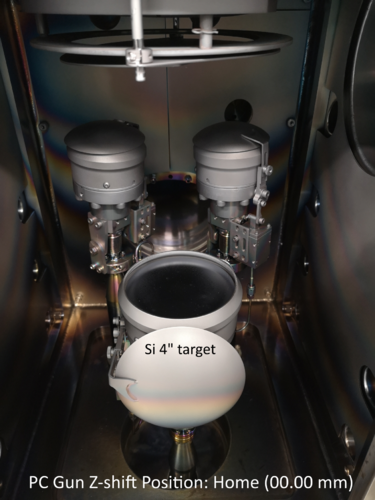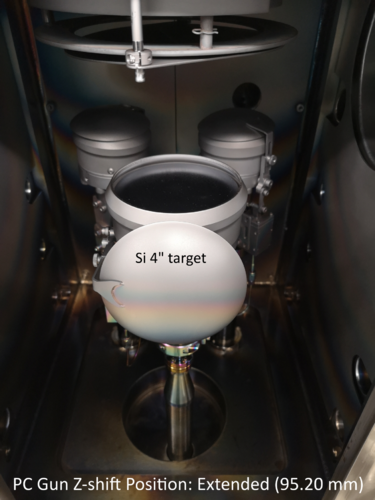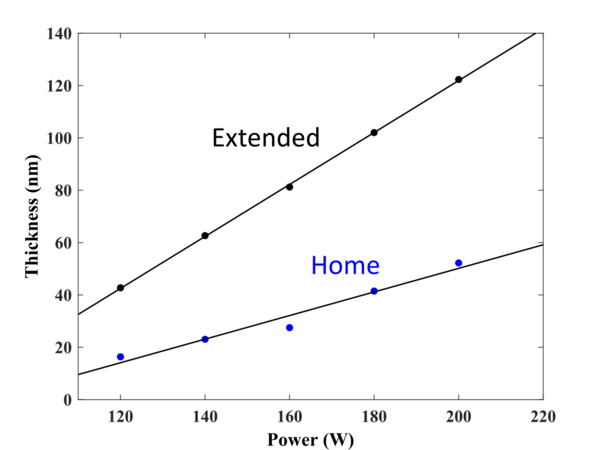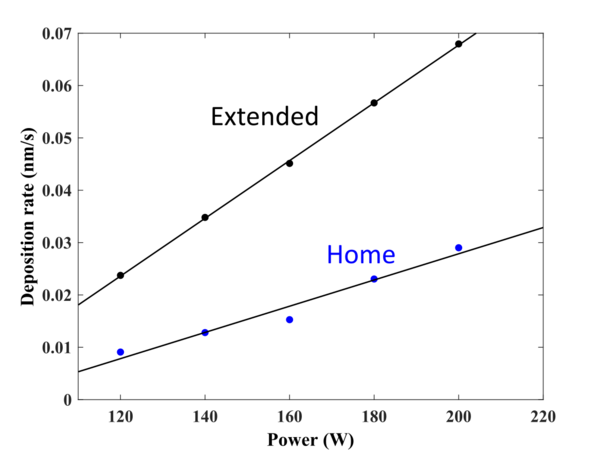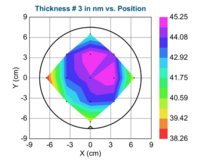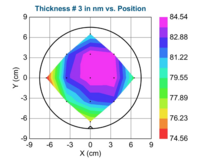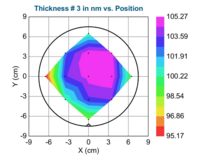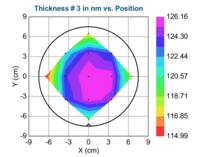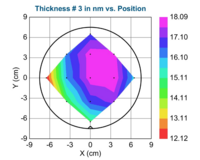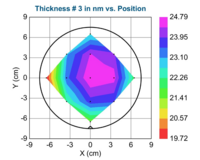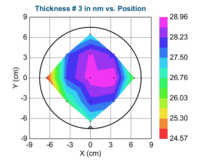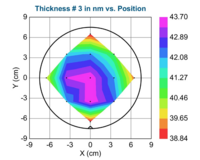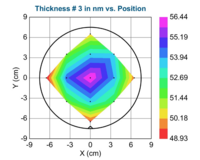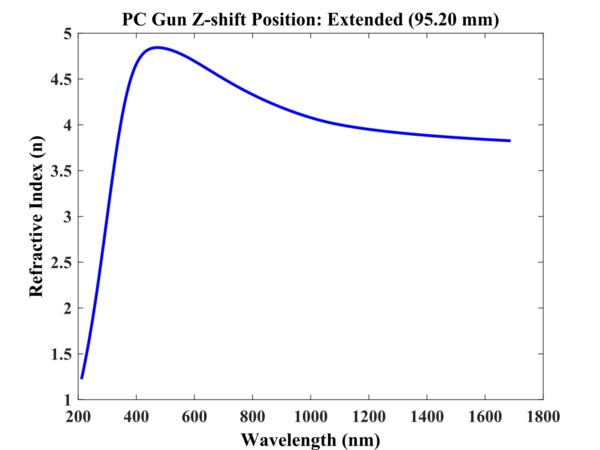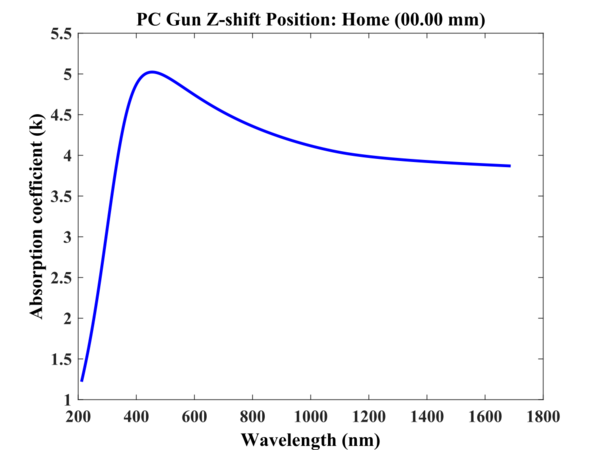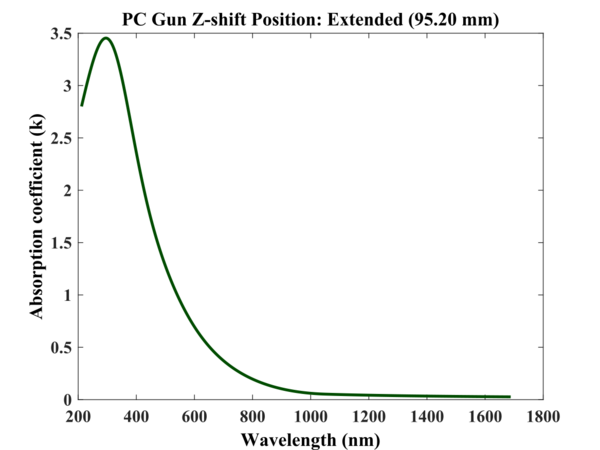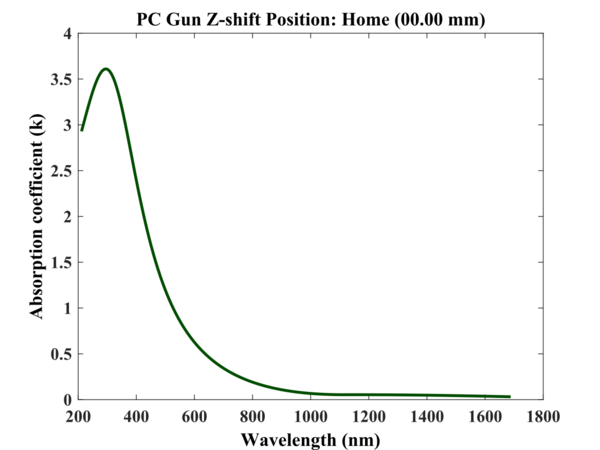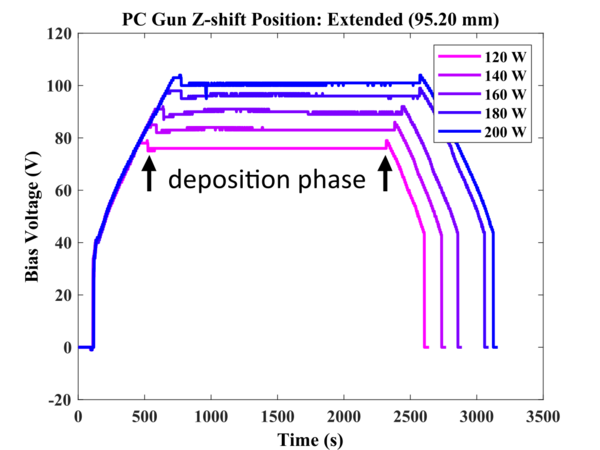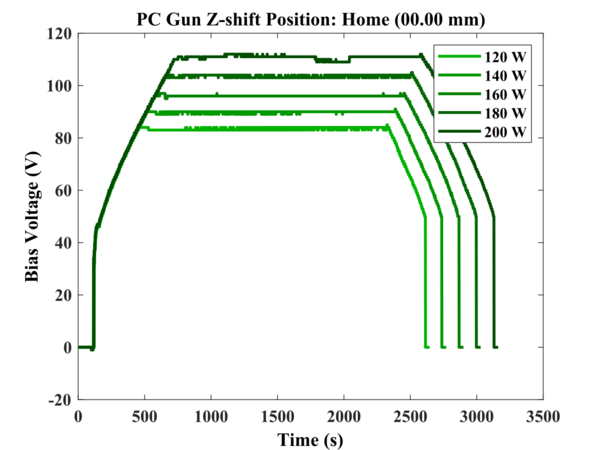Specific Process Knowledge/Thin film deposition/Deposition of Silicon/Si sputter in Sputter-System Metal-Oxide(PC3)
RF Sputtering of Si in Sputter-System Metal-Nitride(PC3)
This page presents the results of Si deposition using RF Sputtering in Sputter-System Metal-Nitride (PC3) commonly known as "Cluster Lesker". The deposition target is 4" Si. Source #1 (in RF mode) was used. Materials from this source can either be deposited with RF or p-DC sputtering, but in this study, only RF was considered.
The deposition and characterization described below were conducted in 2022 by Evgeniy Shkondin, DTU Nanolab. The main focus of the study was the deposition rate, optical functions, and the general performance of deposition from a bigger 4” target. The silicon sputtering from the target of this size allows achieving a higher deposition rate and service to many potential applications where several hundreds of nm are needed to be put uniformly on a wafer of 150mm or similar. Besides, it offers the additional possibility to deposit Si using Cluster Lesker in case another chamber (PC1) where the Si process is also established fails for some reason.
The depositions performed with closed dark space shield configuaration (see photography below). The dark space shield is a circular protection cylinder that sits around the cathode, in its close configuration the top part of the shield is bent toward the target and shadows a few mm of it.
It must be mentioned that the dark space shield should be in a “closed-form” only, as it was observed that the “opened” dark space shield configuration can do a side wall Cu sputtering. This will heavily contaminate the film and gradually damage the tool.
4” magnetron in PC3 has more functionalities compared to the ordinary guns in cluster Lesker. It can(to some degree) moves in Z-direction. This will affect the deposition rate, uniformity and most likely play an important role in reactive sputtering. Besides that, it can be easily tilted if necessary. In this study, two z-high positions have been compared (lowes-“home” and highest –“extended”). The effect of power has also been evaluated.
The Si process recipe in a Sputter-System Metal-Nitride(PC3) is following:
- PC Gun Z-shift Position: Home (00.00 mm) and Extended (95.20 mm)
- Tilt: No (Target in horizontal plane)
- Deposition mode: Upstream
- Rotation speed: 10 rpm
- Pressure: 3 mTorr
- Power: 120-200 W (It is recomended to use 180W for best uniformity if using "Extended" gun Z-shift position).
- Deposition time: 1800s
- Deposition temperature: room temperature
Samples: 6" Si with 300nm SiO2 (from furnace C1 recipe: DRY1100 05:00:00 + 20 min annealing)
- The photography of Si target mounted in 4” magnetron (PC3 Src1).
-
PC Gun Z-shift Position: Home (00.00 mm).
-
PC Gun Z-shift Position: Extended (95.20 mm).
Characterization
Spectroscopic ellipsometry
Thicknesses have been measured by spectroscopic ellipsometry (VASE ellipsometer) across different locations on 6" Si wafer with 300nm dry SiO2. The optical model is based on Tauc-Lorentz and two Lorentz oscillators. The deposition parameters are present in the recipe written above. The results are present in a table below:
| PC Gun Z-shift Position: Extended (95.20 mm) | |||||||
|---|---|---|---|---|---|---|---|
| Deposition conditions
Power (W) |
Time (s) | Pressure (mTorr) | Average (nm) | Standard deviation | Minimum Thickness (nm) | Maximum Thickness (nm) | Rate (nm/s) |
| 120 W | 1800 | 3 | 42.73 | 2.22 | 38.26 | 45.24 | 0.024 |
| 140 W | 1800 | 3 | 62.66 | 2.51 | 56.89 | 65.52 | 0.035 |
| 160 W | 1800 | 3 | 81.23 | 3.17 | 74.56 | 84.54 | 0.045 |
| 180 W | 1800 | 3 | 102.03 | 3.13 | 95.17 | 105.27 | 0.057 |
| 200 W | 1800 | 3 | 122.32 | 3.65 | 114.99 | 126.16 | 0.068 |
| PC Gun Z-shift Position: Home (00.00 mm) | |||||||
|---|---|---|---|---|---|---|---|
| Deposition conditions
Power (W) |
Time (s) | Pressure (mTorr) | Average (nm) | Standard deviation | Minimum Thickness (nm) | Maximum Thickness (nm) | Rate (nm/s) |
| 120 W | 1800 | 3 | 16.36 | 1.69 | 12.12 | 18.09 | 0.009 |
| 140 W | 1800 | 3 | 23.06 | 1.42 | 19.72 | 24.79 | 0.013 |
| 160 W | 1800 | 3 | 27.50 | 1.22 | 24.57 | 28.96 | 0.015 |
| 180 W | 1800 | 3 | 41.48 | 1.75 | 38.84 | 43.70 | 0.023 |
| 200 W | 1800 | 3 | 52.23 | 2.24 | 48.93 | 56.44 | 0.029 |
Deposition rate
- Effect of power on deposition rate (for two different Gun Z-shift Positions).
-
Measured thickness vs. power.
-
Deposition rate as a function of power.
- PC Gun Z-shift Position: Extended (95.20 mm)
Deposition rate (nm/s) =
- PC Gun Z-shift Position: Home (00.00 mm)
Deposition rate (nm/s) =
Uniformity
- Uniformity of deposited Si layer across 6-inch wafer.
-
120 W; PC Gun Z-shift Position: Extended (95.20 mm)
-
140 W; PC Gun Z-shift Position: Extended (95.20 mm)
-
160 W; PC Gun Z-shift Position: Extended (95.20 mm)
-
180 W; PC Gun Z-shift Position: Extended (95.20 mm)
-
200 W; PC Gun Z-shift Position: Extended (95.20 mm)
-
120 W; PC Gun Z-shift Position: Home (00.00 mm)
-
140 W; PC Gun Z-shift Position: Home (00.00 mm)
-
160 W; PC Gun Z-shift Position: Home (00.00 mm)
-
180 W; PC Gun Z-shift Position: Home (00.00 mm)
-
200 W; PC Gun Z-shift Position: Home (00.00 mm)
Optical functions
- Optical constants of deposited Si layer.
-
Refractive index (extended position).
-
Refractive index (home position).
-
Absorption coefficient (extended position).
-
Absorption coefficient (home position).
DC Bias recordings
Any deposition recipe the user runs on Cluster Lesker is getting recorded. Many parameters are stored in the datalog files (in the 1-second interval) that can be accessed and viewed later. Here the DC bias was monitored for the whole experiment.
- DC bias recordings.
-
DC bias variation during the process for different powers (Extended gun position case).
-
DC bias variation during the process for different powers (Home gun position case).

